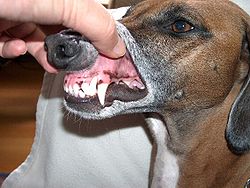Canine (tooth)
| Canine tooth | |
|---|---|

|
|
| Details | |
| Identifiers | |
| Latin | dentes canini |
| MeSH | A14.549.167.860.200 |
| TA | A05.1.03.005 |
| FMA | 55636 |
|
Anatomical terminology
[]
|
|
In mammalian oral anatomy, the canine teeth, also called cuspids, dog teeth, fangs, or (in the case of those of the upper jaw) eye teeth, are relatively long, pointed teeth. However, they can appear more flattened, causing them to resemble incisors and leading them to be called incisiform. They developed and are used primarily for firmly holding food in order to tear it apart, and occasionally as weapons. They are often the largest teeth in a mammal's mouth. Most species that develop them normally have four per mammal, two in the upper jaw and two in the lower, separated within each jaw by its incisors; humans and dogs are examples. In most species, canines are the anterior-most teeth in the maxillary bone.
The four canines in humans are the two maxillary canines and the two mandibular canines.
The Narwal has the longest canines, which can reach lengths from about 1.5 to 3.1 m (4 ft 11 in to 10 ft 2 in).
There are four canine teeth: two in the upper (maxillary) and two in the lower (mandibular) arch. A canine is placed laterally to each lateral incisor. They are larger and stronger than the incisors, and their roots sink deeply into the bones, and cause well-marked prominences upon the surface.
The crown is large and conical, very convex on its labial surface, a little hollowed and uneven on its lingual surface, and tapering to a blunted point or cusp, which projects beyond the level of the other teeth. The root is single, but longer and thicker than that of the incisors, conical in form, compressed laterally, and marked by a slight groove on each side. The lingual surface also presents two depressions on either side of the surface separated by a ridge in between; these depressions are known as mesial and distal lingual fossae.
In humans, the upper canine teeth (popularly called eye teeth, from their position under the eyes) are larger and longer than the lower, and usually present a distinct basal ridge. Eruption typically occurs between the ages of eleven and twelve years.
...
Wikipedia
